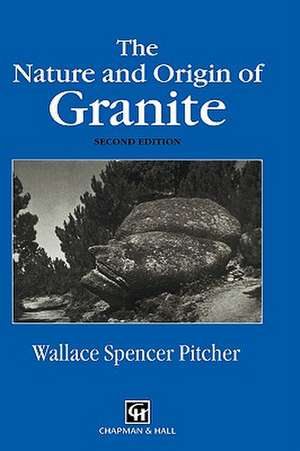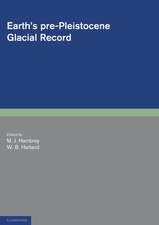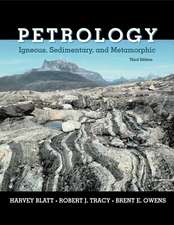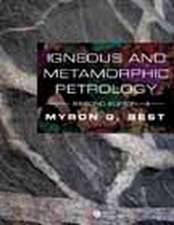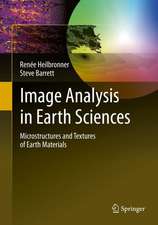The Nature and Origin of Granite
Autor W.S. Pitcheren Limba Engleză Hardback – 31 aug 1997
| Toate formatele și edițiile | Preț | Express |
|---|---|---|
| Paperback (2) | 390.46 lei 43-57 zile | |
| SPRINGER NETHERLANDS – 25 sep 2013 | 390.46 lei 43-57 zile | |
| SPRINGER NETHERLANDS – 9 oct 2012 | 949.73 lei 43-57 zile | |
| Hardback (1) | 955.88 lei 43-57 zile | |
| SPRINGER NETHERLANDS – 31 aug 1997 | 955.88 lei 43-57 zile |
Preț: 955.88 lei
Preț vechi: 1165.70 lei
-18% Nou
Puncte Express: 1434
Preț estimativ în valută:
182.90€ • 191.48$ • 151.34£
182.90€ • 191.48$ • 151.34£
Carte tipărită la comandă
Livrare economică 07-21 aprilie
Preluare comenzi: 021 569.72.76
Specificații
ISBN-13: 9780412758607
ISBN-10: 0412758601
Pagini: 387
Ilustrații: XVI, 387 p.
Dimensiuni: 155 x 235 x 24 mm
Greutate: 0.74 kg
Ediția:2nd ed. 1997
Editura: SPRINGER NETHERLANDS
Colecția Springer
Locul publicării:Dordrecht, Netherlands
ISBN-10: 0412758601
Pagini: 387
Ilustrații: XVI, 387 p.
Dimensiuni: 155 x 235 x 24 mm
Greutate: 0.74 kg
Ediția:2nd ed. 1997
Editura: SPRINGER NETHERLANDS
Colecția Springer
Locul publicării:Dordrecht, Netherlands
Public țintă
ResearchCuprins
1 The historical perspective: an ever changing emphasis.- 2 The categories of granitic rocks: the search for a genetic typology.- 3 Granite as a chemical system: the experimental impact.- 4 The physical nature of granitic magmas: a case of missing information.- 5 The evolution of the granitic texture: a continuum of crystal growth.- 6 Differentiation in granitic magmas: zoning as an example of multifactorial processes at work.- 7 The volcano-plutonic interface: not Read’s hiatus.- 8 The evidence for restite: unmixing as an alternative hypothesis.- 9 The mingling and mixing of granite with basalt: a third term in a multiple hypothesis.- 10 Appinites, diatremes and granodiorites: the interaction of ‘wef’basalt with granite.- 11 Controls of upwelling and emplacement: the response of the envelope: balloons, pistons and reality.- 12 On the rates of emplacement, crystallization and cooling.- 13 Plagiogranite and f errogranophyre: extreme differentiation in contrasted situations.- 14 Cordilleran-type batholiths: magmatism and crust formation at a plate edge.- 15 Intraplate, rift-related magmatism: mainly the A-type, alkali feldspar granites.- 16 Migmatites: are they a source of granitic plutons?.- 17 The waning stages: the role of volatiles in the genesis of pegmatites and metal ores.- 18 The sources of granitic magmas in their various global tectonic niches.- 19 A kind of conclusion: a search for order among multifactorial processes and multifarious interactions.
Recenzii
about the first edition:
`Without doubt, Wallace Pitcher is currently the granite specialist ... an essential book for deep-zone geologists, whether granitologists or not.'
Geotechnique
`... this excellent and very readable book by an acknowledged master of the craft. The book should be read by anybody interested in granites. It is notable for the breadth of its approach and valuable for presenting the summarized work of a geologist who has made a notable contribution over a lifetime of work.'
Journal of Petrology
`This book is a must for all those engaged in the study of granites, and igneous rocks in general, from undergraduates to professors. It is also an essential library addition. In summary, crucial reading for anyone interested in the origin of granite.'
Geological Magazine
`Without doubt, Wallace Pitcher is currently the granite specialist ... an essential book for deep-zone geologists, whether granitologists or not.'
Geotechnique
`... this excellent and very readable book by an acknowledged master of the craft. The book should be read by anybody interested in granites. It is notable for the breadth of its approach and valuable for presenting the summarized work of a geologist who has made a notable contribution over a lifetime of work.'
Journal of Petrology
`This book is a must for all those engaged in the study of granites, and igneous rocks in general, from undergraduates to professors. It is also an essential library addition. In summary, crucial reading for anyone interested in the origin of granite.'
Geological Magazine
